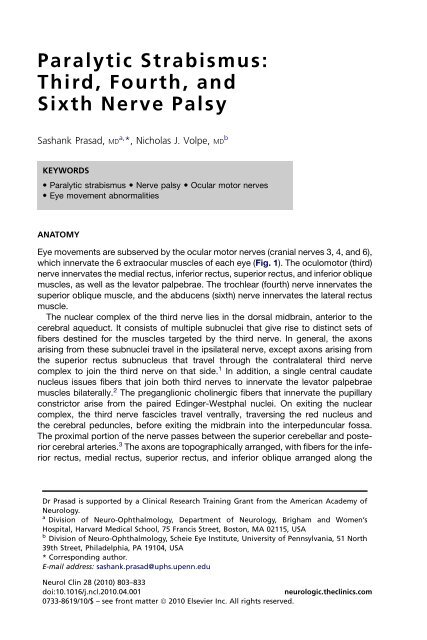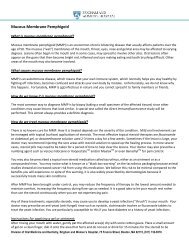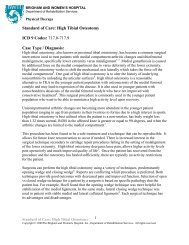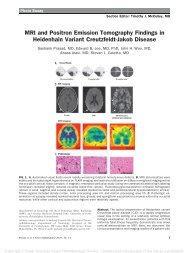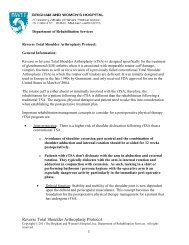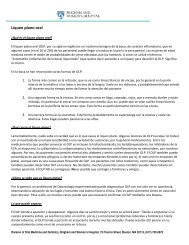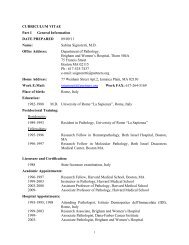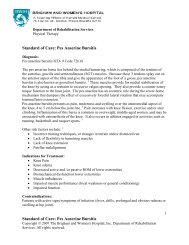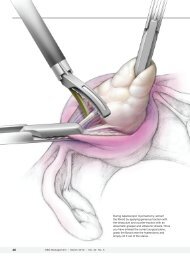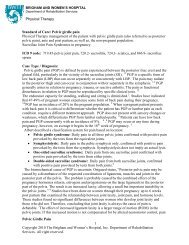Paralytic Strabismus: Third, Fourth, and Sixth Nerve Palsy
Paralytic Strabismus: Third, Fourth, and Sixth Nerve Palsy
Paralytic Strabismus: Third, Fourth, and Sixth Nerve Palsy
Create successful ePaper yourself
Turn your PDF publications into a flip-book with our unique Google optimized e-Paper software.
<strong>Paralytic</strong> <strong>Strabismus</strong>:<br />
<strong>Third</strong>, <strong>Fourth</strong>, <strong>and</strong><br />
<strong>Sixth</strong> <strong>Nerve</strong> <strong>Palsy</strong><br />
Sashank Prasad, MD a, *, Nicholas J. Volpe, MD b<br />
KEYWORDS<br />
<strong>Paralytic</strong> strabismus <strong>Nerve</strong> palsy Ocular motor nerves<br />
Eye movement abnormalities<br />
ANATOMY<br />
Eye movements are subserved by the ocular motor nerves (cranial nerves 3, 4, <strong>and</strong> 6),<br />
which innervate the 6 extraocular muscles of each eye (Fig. 1). The oculomotor (third)<br />
nerve innervates the medial rectus, inferior rectus, superior rectus, <strong>and</strong> inferior oblique<br />
muscles, as well as the levator palpebrae. The trochlear (fourth) nerve innervates the<br />
superior oblique muscle, <strong>and</strong> the abducens (sixth) nerve innervates the lateral rectus<br />
muscle.<br />
The nuclear complex of the third nerve lies in the dorsal midbrain, anterior to the<br />
cerebral aqueduct. It consists of multiple subnuclei that give rise to distinct sets of<br />
fibers destined for the muscles targeted by the third nerve. In general, the axons<br />
arising from these subnuclei travel in the ipsilateral nerve, except axons arising from<br />
the superior rectus subnucleus that travel through the contralateral third nerve<br />
complex to join the third nerve on that side. 1 In addition, a single central caudate<br />
nucleus issues fibers that join both third nerves to innervate the levator palpebrae<br />
muscles bilaterally. 2 The preganglionic cholinergic fibers that innervate the pupillary<br />
constrictor arise from the paired Edinger-Westphal nuclei. On exiting the nuclear<br />
complex, the third nerve fascicles travel ventrally, traversing the red nucleus <strong>and</strong><br />
the cerebral peduncles, before exiting the midbrain into the interpeduncular fossa.<br />
The proximal portion of the nerve passes between the superior cerebellar <strong>and</strong> posterior<br />
cerebral arteries. 3 The axons are topographically arranged, with fibers for the inferior<br />
rectus, medial rectus, superior rectus, <strong>and</strong> inferior oblique arranged along the<br />
Dr Prasad is supported by a Clinical Research Training Grant from the American Academy of<br />
Neurology.<br />
a Division of Neuro-Ophthalmology, Department of Neurology, Brigham <strong>and</strong> Women’s<br />
Hospital, Harvard Medical School, 75 Francis Street, Boston, MA 02115, USA<br />
b Division of Neuro-Ophthalmology, Scheie Eye Institute, University of Pennsylvania, 51 North<br />
39th Street, Philadelphia, PA 19104, USA<br />
* Corresponding author.<br />
E-mail address: sashank.prasad@uphs.upenn.edu<br />
Neurol Clin 28 (2010) 803–833<br />
doi:10.1016/j.ncl.2010.04.001<br />
neurologic.theclinics.com<br />
0733-8619/10/$ – see front matter ª 2010 Elsevier Inc. All rights reserved.
804<br />
Prasad & Volpe<br />
Fig. 1. Anatomic structures subserving eye movements: lateral view of the right eye. The<br />
oculomotor nerve (CN III), trochlear nerve (CN IV), <strong>and</strong> abducens nerve (CN VI) arise from<br />
the brainstem. After passing through the subarachnoid space <strong>and</strong> cavernous sinus, they<br />
enter the orbit through the superior orbital fissure. The oculomotor nerve divides into superior<br />
<strong>and</strong> inferior divisions, <strong>and</strong> ultimately innervates the superior rectus, inferior rectus,<br />
medial rectus, inferior oblique (shown cut), <strong>and</strong> levator palpebrae muscles. In addition,<br />
parasympathetic fibers of the third nerve synapse in the ciliary ganglion then innervate<br />
the pupillary constrictor muscle. The trochlear nerve innervates the superior oblique muscle.<br />
The abducens nerve innervates the lateral rectus muscle (shown cut). (Adapted from Agur<br />
AMR, Dalley AF. Grant’s atlas of anatomy. 12th edition. Philadelphia: Lippincott, Williams<br />
& Wilkins; 2009; with permission.)<br />
medial-to-lateral axis. Pupillary fibers are generally located superficially, in the superior<br />
<strong>and</strong> medial portion of the nerve.<br />
The trochlear (fourth) nucleus is situated in the pontomesencephalic junction,<br />
ventral to the cerebral aqueduct. Unlike all other cranial nerves, these axons exit the<br />
brainstem dorsally. They then decussate within the anterior medullary velum (beneath<br />
the inferior colliculi), <strong>and</strong> ultimately innervate the contralateral superior oblique muscle.<br />
The abducens (sixth) nucleus lies in the dorsal pons, in close proximity to the facial<br />
(seventh) nerve fascicle. The sixth nerve fascicle travels ventrally, through the corticospinal<br />
tracts, before exiting anterolaterally at the pontomedullary junction.<br />
The 3 ocular motor nerves pass through the subarachnoid space before piercing the<br />
dura <strong>and</strong> arriving at the cavernous sinus (Fig. 2). Although the third <strong>and</strong> fourth nerves<br />
are situated along the lateral wall of the cavernous sinus, the abducens nerve has<br />
a more medial position, just lateral to the internal carotid artery. The third nerve splits<br />
into superior <strong>and</strong> inferior divisions within the anterior cavernous sinus. The superior<br />
division innervates the levator palpebrae <strong>and</strong> the superior rectus muscles, whereas<br />
the inferior division innervates the remaining third nerve muscles (the medial rectus,<br />
inferior rectus, inferior oblique, <strong>and</strong> the pupillary constrictor). All 3 ocular motor nerves<br />
exit the cavernous sinus via the superior orbital fissure, <strong>and</strong> then pass through the<br />
orbital apex to reach their target muscles.<br />
The blood supply to the third, fourth, <strong>and</strong> sixth nerves has multiple sources that feed<br />
a vasa nervorum capillary network. 4 In the subarachnoid space, the third nerve is<br />
supplied by small thalamomesenchephalic branches from the basilar artery <strong>and</strong><br />
posterior ciliary artery (PCA); in the cavernous sinus, it is supplied by branches of
<strong>Paralytic</strong> <strong>Strabismus</strong> 805<br />
Fig. 2. The cavernous sinus, coronal view. The oculomotor nerve <strong>and</strong> trochlear nerve are situated<br />
on the lateral wall of the cavernous sinus (along with the ophthalmic <strong>and</strong> maxillary<br />
divisions of the trigeminal nerve). The abducens nerve floats freely within the cavernous<br />
sinus. The internal carotid artery is located medially in the cavernous sinus, <strong>and</strong> the pituitary<br />
gl<strong>and</strong> is within the sella turcica in the midline. (Reprinted from Drake R, Vogl W, Mitchell A.<br />
Gray’s anatomy for students. 2nd edition. London: Churchill Livingstone; 2010; with<br />
permission.)<br />
the intracavernous carotid, <strong>and</strong> within the orbit its supply arises from recurrent<br />
branches of the ophthalmic artery. A watershed zone may exist between the<br />
subarachnoid <strong>and</strong> intracavernous portions of this blood supply. 5 In the subarachnoid<br />
segment, the blood supply of the fourth nerve comprises branches from the superior<br />
cerebellar artery (SCA), <strong>and</strong> that of the sixth nerve arises from branches of the PCA<br />
<strong>and</strong> SCA. 4 In the cavernous sinus <strong>and</strong> the orbit, the blood supply to both of these<br />
nerves arises from the same vessels that supply the third nerve.<br />
THIRD NERVE PALSY<br />
Clinical Features<br />
Complete, isolated third nerve palsy causes ipsilateral weakness of elevation, depression,<br />
<strong>and</strong> adduction of the globe, in combination with ptosis <strong>and</strong> mydriasis. Depending<br />
on the specific cause, complete third nerve palsy may involve the pupil (causing mydriasis)<br />
or spare the pupil (Figs. 3 <strong>and</strong> 4). In partial third nerve palsy, different patterns of<br />
impaired motility may occur with or without pupillary involvement. The motility deficit<br />
may be subtle, <strong>and</strong> a reduced duction may not be easily observed. In this case, more<br />
detailed assessment of alignment, with alternate cover or Maddox rod testing, will
806<br />
Prasad & Volpe<br />
Fig. 3. A 32-year-old woman with traumatic complete left third nerve palsy, showing right<br />
hypertropia in upgaze that becomes left hypertropia in downgaze. (A) Left ptosis, mydriasis,<br />
exotropia, <strong>and</strong> right hypertropia in primary gaze. (B) Absent left elevation. (C) Reduced left<br />
depression. (D) The left pupil shows minimal consensual response to light, with greater<br />
anisocoria.<br />
show an incomitant pattern of ocular misalignment supporting the diagnosis of partial<br />
third nerve palsy. A characteristic feature is that the affected eye is hypotropic in<br />
upgaze but hypertropic in downgaze, because of the combined weakness of the superior<br />
<strong>and</strong> inferior rectus muscles.<br />
As opposed to lesions of the third nerve fascicle or nerve, a lesion of the third nerve<br />
nucleus will cause bilateral abnormalities. Specifically, there is bilateral ptosis<br />
(because the central caudal nucleus supplies both levator palpebrae muscles) <strong>and</strong><br />
a bilateral elevation deficit (because the superior rectus subnucleus sends fibers<br />
through the contralateral third nerve nucleus to join the opposite nerve) (Fig. 5). 1,6,7<br />
Therefore, the classic clinical picture of unilateral nuclear third nerve palsy is ipsilateral<br />
mydriasis; ipsilateral weakness of the medial rectus, inferior rectus, <strong>and</strong> inferior oblique<br />
muscles; bilateral ptosis; <strong>and</strong> bilateral superior rectus weakness.<br />
As the third nerve fascicle travels ventrally through the midbrain, it is vulnerable to an<br />
intraparenchymal lesion. Partial deficits are possible, in keeping with the topographic<br />
arrangement of fibers within the nerve fascicle. 2,8–10 In these cases, other neurologic<br />
deficits often accompany the third nerve palsy. For example, a lesion also affecting the<br />
corticospinal tracts in the cerebral peduncle will cause contralateral hemiparesis<br />
(Weber syndrome), a lesion involving the red nucleus will cause contralateral limb
<strong>Paralytic</strong> <strong>Strabismus</strong> 807<br />
Fig. 4. A 55-year-old woman with a microvasculopathic partial right third nerve palsy due to<br />
diabetes <strong>and</strong> hypertension. Magnetic resonance imaging <strong>and</strong> magnetic resonance angiography<br />
were normal. (A) Right ptosis without mydriasis in primary position. Mild physiologic<br />
anisocoria was present. (B) Normal right gaze. (C) Decreased right adduction on left gaze.<br />
(D) Decreased right elevation on upgaze. (E) Decreased right depression on downgaze.<br />
The motility became normal within 8 weeks.<br />
tremor (Benedikt syndrome), <strong>and</strong> a lesion involving the brachium conjunctivum<br />
(involving the crossing dentatorubrothalamic fibers of the superior cerebellar<br />
peduncle) will cause contralateral ataxia (Claude syndrome). 11 Rarely, fascicular third<br />
nerve palsy may occur in isolation. 6<br />
Given the segregation of the third nerve into superior <strong>and</strong> inferior divisions, a lesion<br />
of the anterior cavernous sinus or orbit may cause selective impairments. Disruption of<br />
the superior division causes ptosis <strong>and</strong> impaired elevation, whereas disruption of the<br />
inferior division causes impaired depression, adduction, <strong>and</strong> mydriasis (Figs. 6 <strong>and</strong> 7). 12<br />
However, in rare cases, more proximal lesions (ie, intraparenchymal fascicular lesions<br />
or subarachnoid lesions) may mimic a divisional palsy. 10,13–16<br />
Aberrant regeneration refers to miswiring of third nerve innervated structures,<br />
leading to patterns of co-contraction (ie, synkinesis). 17 Common manifestations are<br />
contraction of the levator palpebrae on adduction or depression of the eye, or miosis<br />
of a dilated pupil during adduction (Fig. 8). This phenomenon occurs in primary <strong>and</strong><br />
secondary forms. Primary aberrant regeneration suggests chronic compression, typically<br />
due to an exp<strong>and</strong>ing cavernous sinus lesion such as a meningioma, aneurysm,<br />
tumor, or other mass. 18–20 Secondary aberrant regeneration occurs in the recovery<br />
phase following acute third nerve palsy, commonly after trauma but also after ophthalmoplegic<br />
migraine, pituitary apoplexy, or inflammation. Aberrant regeneration does<br />
not occur after vasculopathic third nerve palsy.<br />
Differential Diagnosis<br />
Nuclear or fascicular third nerve palsy is typically due to midbrain infarction from<br />
occlusion of a small penetrating artery from the proximal PCA. Other possible causes<br />
of midbrain disease include tumors, vascular malformations, abscesses, demyelination,<br />
<strong>and</strong> inflammatory disorders.<br />
In the subarachnoid space, an exp<strong>and</strong>ing aneurysm of the posterior communicating<br />
artery (PComm) is an important cause of third nerve palsy. More than 90% of patients
808<br />
Prasad & Volpe
<strong>Paralytic</strong> <strong>Strabismus</strong> 809<br />
with subarachnoid hemorrhage from a PComm aneurysm initially present with a third<br />
nerve palsy. 21,22 These aneurysms commonly project posterolaterally to compress the<br />
third nerve <strong>and</strong> involve the pupillary fibers in most cases. When the motility deficits are<br />
complete, pupillary involvement is virtually always present. If the motility deficit is<br />
partial, then the pupil may initially be spared. 23 Sparing of pupillomotor fibers may<br />
occur because they are resistant to evenly distributed compression, or because<br />
they are positioned dorsally, <strong>and</strong> in some cases compression is limited to the inferior<br />
aspect of the nerve. 24 A PComm aneurysm presenting acutely as a third nerve palsy<br />
represents a true neurosurgical emergency <strong>and</strong> may be treated by surgical clipping or<br />
endovascular coiling. 25<br />
Microvascular third nerve palsy is commonly associated with risk factors including<br />
hypertension, diabetes, hyperlipidemia, advanced age, <strong>and</strong> smoking (see Fig. 4). This<br />
disorder results from impairment of microcirculation leading to circumscribed,<br />
ischemic demyelination of axons at the core of the nerve, typically in the cavernous<br />
sinus portion where a watershed territory exists. 5,26 Most of these patients exhibit<br />
pupillary sparing, because the pupillary fibers are located peripherally, closest to<br />
the blood supply provided by the surrounding vasa nervorum. However, some pupillary<br />
involvement may occur, typically with less than 1 mm (up to a maximum of 2.5<br />
mm) of anisocoria found in approximately 40% of cases. 27 A microvascular third nerve<br />
palsy is frequently associated with orbital pain, which can be severe. Although it<br />
remains uncertain, the pain may result from ischemia of trigeminal sensory fibers<br />
that join the third nerve within the cavernous sinus. 28 There is an excellent prognosis<br />
for recovery of motility deficits from microvascular third nerve palsy, typically in 8 to 12<br />
weeks. 29<br />
Severe trauma is another common cause of third nerve palsies, involving traction at<br />
the skull base or fracture of the bones of the orbit or skull base (Fig. 9). 30,31 A third<br />
nerve palsy that follows minor head trauma may indicate an underlying structural<br />
lesion. 32,33 Although there is good prognosis for recovery following traumatic third<br />
nerve palsy, there is a high incidence of secondary aberrant regeneration.<br />
Slowly progressive third nerve palsies occasionally occur due to growth of a primary<br />
tumor of the nerve or nerve sheath. These lesions include neurinomas, neurofibromas,<br />
neurilemmomas, <strong>and</strong> schwannomas. 34 Neuroimaging will identify an enlarged,<br />
enhancing nerve in these cases. Uncommonly, a malignant meningioma, glioblastoma<br />
multiforme, or lymphoma may directly affect the third nerve. 35<br />
Uncal herniation can cause direct compression of the third nerve against the free<br />
edge of the tentorium. In addition to third nerve deficits, these patients will have<br />
depressed mental status among other prominent neurologic deficits. In this situation,<br />
isolated pupil dilation may be the earliest manifestation of third nerve dysfunction.<br />
However, an isolated dilated pupil is never a manifestation of third nerve dysfunction<br />
in an awake <strong>and</strong> alert patient.<br />
:<br />
Fig. 5. A 15-year-old boy with bilateral nuclear third nerve palsies following resection of<br />
a midline juvenile pilocytic astrocytoma. (A) Severe bilateral ptosis in primary gaze. Note<br />
compensatory contraction of the frontalis muscle. (B) Reduced left adduction. Mydriasis<br />
of the left pupil is observed. (C) Slightly reduced right adduction. (D) Severe elevation limitation<br />
on attempted upgaze. The vertical gaze limitation was not overcome by the oculocephalic<br />
maneuver. (E) Bilateral depression deficit, greater on the right than on the left.<br />
Preoperative axial fluid-attenuated inversion-recovery (FLAIR) (F) <strong>and</strong> sagittal T2-weighted<br />
brain MRI (G) revealed a large heterogeneous midline mass (arrow) compressing the dorsal<br />
midbrain <strong>and</strong> causing hydrocephalus. Axial (H) <strong>and</strong> coronal MRI (I) 2 years following surgical<br />
resection showing focal volume loss in the dorsal midbrain (arrow).
810<br />
Prasad & Volpe<br />
Fig. 6. 63-year-old woman with right superior divisional third nerve palsy following resection<br />
of right sphenoid wing meningioma, causing isolated dysfunction of the levator palpebrae<br />
<strong>and</strong> superior rectus muscles. (A) Complete right ptosis. (B) Slight right hypotropia in<br />
primary gaze. (C) Right hypotropia in right gaze. (D) Slight right hypotropia in left gaze.<br />
(E) Markedly reduced elevation of the right eye. (F) Normal downgaze. (G) Preoperative<br />
postcontrast T1-weighted brain MRI showing right sphenoid wing meningioma (arrow).<br />
In the pediatric population, ophthalmoplegic migraine may cause transient isolated<br />
third nerve palsy. This rare form of complicated migraine typically presents before the<br />
age of 10 years. 36 Ispilateral headache <strong>and</strong> nausea often accompany abnormal eye<br />
movements. For unclear reasons, third nerve involvement is most common, occurring<br />
in 95% of cases. The cause may relate to transient ischemia or compression of the<br />
nerve within the cavernous sinus by an edematous, dilated carotid artery. 37,38 This<br />
condition is a diagnosis of exclusion, after a workup including imaging, blood work,<br />
<strong>and</strong> often lumbar puncture are unrevealing. Ophthalmoplegic migraine should be<br />
considered extremely unlikely in an adult without prior history of similar episodes in<br />
childhood.<br />
Isolated persistent third nerve palsy in childhood is commonly a congenital defect. 39<br />
These cases are believed to result from aplasia or maldevelopment of the structures of<br />
the ocular motor nucleus due to in utero insult. 40 The motility deficit <strong>and</strong> ptosis is
<strong>Paralytic</strong> <strong>Strabismus</strong> 811<br />
Fig. 7. An 8-year-old girl with idiopathic postviral left inferior divisional third nerve palsy,<br />
causing isolated dysfunction of the medial rectus, inferior rectus, <strong>and</strong> pupillary constrictor<br />
muscles. Brain MRI <strong>and</strong> spinal fluid constituents were normal. (A) Left mydriasis <strong>and</strong> exotropia.<br />
(B) Complete left adduction deficit on right gaze. (C) Normal left gaze. (D) Normal upgaze<br />
bilaterally (not fully seen in this photograph). (E) Left depression deficit. (F) At 3-month<br />
follow-up, there was marked improvement of the motility deficit, with residual left mydriasis<br />
(anisocoria greatest in light). (G) Left adduction deficit has resolved. (H) Left gaze<br />
remains normal. (I) Upgaze remains normal. (J) Slight left depression deficit persists.<br />
typically accompanied by miosis, rather than mydriasis, which probably results from<br />
anomalous innervation of the pupillary constrictor. Cyclic oculomotor spasms may<br />
occur, which are characterized by brief (10–30 seconds), involuntary contractions of<br />
third nerve innervated structures, causing periods of adduction, lid elevation, <strong>and</strong><br />
miosis. 41 This condition rarely occurs with acquired third nerve palsy, typically due<br />
to a compressive lesion.<br />
<strong>Third</strong> nerve palsy frequently occurs in combination with other cranial nerve deficits.<br />
The disorders capable of affecting multiple cranial nerves include cavernous sinus<br />
lesions, neoplasms of the base of the skull, carcinomatous meningitis, sinus mucoceles,<br />
infections, <strong>and</strong> inflammatory conditions. These conditions are discussed later<br />
in this article.
812<br />
Prasad & Volpe<br />
Fig. 8. A 45-year-old woman with aberrant regeneration following traumatic left third<br />
nerve palsy. (A) Left mydriasis, exotropia, <strong>and</strong> right hypertropia in primary position. (B)<br />
Reduced left adduction with synkinetic left pupillary constriction <strong>and</strong> left lid elevation.<br />
(C) Complete left gaze (not fully shown in this photograph). (D) Reduced left elevation.<br />
(E) Reduced left depression with abnormal lid elevation due to synkinesis.<br />
Fig. 9. A 14-year-old boy with left partial third nerve palsy following head trauma. (A)<br />
Complete left ptosis. (B) Reduced left adduction. No mydriasis is evident. (C) Complete<br />
left gaze. (D) Reduced left elevation. (E) Normal depression. (F) Noncontrast head computed<br />
tomography (CT) revealed frontal contusions (black arrow), occipital fracture, <strong>and</strong> epidural<br />
hematoma (white arrow). The motility deficit recovered completely within 3 months,<br />
without aberrant regeneration.
<strong>Paralytic</strong> <strong>Strabismus</strong> 813<br />
Diagnostic Testing<br />
The appropriate workup for a patient with third nerve palsy depends on the patient’s<br />
age <strong>and</strong> pupil function. In adults with acquired, isolated, complete, or partial third<br />
nerve palsy that involves the pupil, there is no controversy to the workup: these<br />
patients need urgent imaging to exclude a PComm aneurysm or other mass. 42,43<br />
Computed tomography angiography (CTA) <strong>and</strong> magnetic resonance angiography<br />
are useful, but the exact sensitivity <strong>and</strong> availability of these tests vary across institutions.<br />
44 Nevertheless, if these tests are negative, a catheter angiogram often remains<br />
necessary in these patients because small aneurysms are potentially missed on noninvasive<br />
imaging studies.<br />
For patients with complete, pupil-sparing third nerve palsy who are more than 50<br />
years of age <strong>and</strong> have vascular risk factors, clinical observation may be reasonable. If<br />
these patients fail to spontaneously recover within 12 weeks, then detailed neuroimaging<br />
is necessary. However, the appropriate threshold for obtaining imaging in this patient<br />
population remains an ongoing source of controversy. There are a growing number of<br />
reports of lesions diagnosed by magnetic resonance imaging (MRI) in patients who<br />
mimicked microvasculopathic third nerve palsy. 43 Therefore, in clinical practice it may<br />
be prudent to obtain imaging studies to exclude vascular lesions in these patients.<br />
In patients with partial, pupil-sparing third nerve palsies, the threshold to obtain<br />
imaging is also low. Historically, it would have been reasonable to observe these<br />
patients for several days; in cases of evolving acute third nerve palsy due to aneurysm,<br />
mydriasis would occur in almost all cases within that time period. 23 If mydriasis<br />
develops, urgent imaging becomes necessary. If the motility deficit remains unaccompanied<br />
by pupillary abnormalities after 1 week, then a microvasculopathic cause is<br />
most likely. In the modern era, given the high risks of missing the diagnosis of an aneurysm<br />
<strong>and</strong> the increased availability of magnetic resonance (MR) or computed tomography<br />
(CT) imaging, it has become an appropriate strategy to obtain imaging in these<br />
patients earlier.<br />
Consideration of imaging should also be given to patients with third nerve palsy<br />
due to trauma, especially if the extent of trauma was minor, because of the incidence<br />
of underlying mass lesions (including aneurysms). Imaging these patients<br />
will also evaluate for muscle entrapment due to fracture of the orbital wall.<br />
In cases in which an infectious, inflammatory, or neoplastic cause is suspected, <strong>and</strong><br />
MRI is negative or nonspecific, additional workup may include serologies for Lyme<br />
disease, syphilis, <strong>and</strong> an erythrocyte sedimentation rate to exclude temporal arteritis.<br />
Cerebrospinal fluid (CSF) analysis including cell counts, protein, glucose, cytology,<br />
<strong>and</strong> Lyme <strong>and</strong> Venereal Disease Reference Laboratory (VDRL) titers may be required.<br />
Treatment<br />
The treatment of diplopia due to acute third nerve palsy may include monocular patching<br />
or prisms. If the third nerve palsy is improving quickly over several weeks, prisms<br />
may be unnecessary <strong>and</strong> difficult to use successfully. If the misalignment remains fairly<br />
stable, then prisms may reduce diplopia in primary gaze. However, given the incomitance<br />
of these deviations, prisms are unlikely to alleviate diplopia in eccentric gaze,<br />
<strong>and</strong> patient satisfaction may vary.<br />
Once ocular misalignment from third nerve palsy has been stable for 6 to 12 months,<br />
surgical correction can be considered. The complexity of these cases depends on<br />
whether the third nerve palsy is complete or partial. Complete third nerve palsy presents<br />
a highly incomitant deviation in the horizontal <strong>and</strong> vertical planes. The ultimate<br />
goal for surgery in these cases is to establish single binocular vision in the primary<br />
position. 45 Exodeviation in the primary position may be reduced by performing
814<br />
Prasad & Volpe<br />
a supramaximal lateral rectus recession (a weakening procedure that completely abolishes<br />
abduction), potentially in combination with a medial rectus resection (a tightening<br />
procedure to augment the muscle’s action). A medial rectus resection alone<br />
often becomes ineffective in these cases. Other strategies include transposition of<br />
the horizontal muscles to facilitate vertical eye movements <strong>and</strong> transposition of the<br />
superior oblique tendon to create an adducting force.<br />
For patients with partial third nerve palsy, the surgical plan is tailored to the specific<br />
pattern of misalignment. In general, a combination of procedures is used to achieve<br />
better alignment. These include resection of the partially paretic muscle <strong>and</strong> recession<br />
or posterior fixation suture of the contralateral yoke muscle. A posterior fixation suture<br />
creates a mild limitation of eye movement without affecting primary position. A recession<br />
procedure can be done with adjustable sutures so that the realignment can be<br />
fine-tuned based on the awake patient’s subjective experience. 46 For instance,<br />
a patient with partial third nerve palsy causing isolated impairment of elevation or<br />
depression can be treated with a resection of the involved vertical muscle combined<br />
with an adjustable recession (or posterior fixation suture) of the contralateral yoke<br />
muscle, producing an improved field of single binocular vision.<br />
The risks of surgery should be weighed carefully in the decision to treat patients with<br />
third nerve palsy. Patients should be warned that more disabling diplopia may occur<br />
following strabismus surgery, as the images from each eye become perceived much<br />
closer together. Correction of ptosis accompanying third nerve palsy is usually easily<br />
accomplished but carries some risk of corneal exposure.<br />
FOURTH NERVE PALSY<br />
Clinical Features<br />
<strong>Fourth</strong> nerve palsy presents with vertical diplopia <strong>and</strong> is commonly accompanied by<br />
compensatory contralateral head tilt. 47 Identification of a fourth nerve palsy in a patient<br />
with vertical diplopia involves application of the Parks-Bielchowsky three-step test.<br />
First, hypertropia suggests weakness of the ipsilateral superior oblique, ipsilateral inferior<br />
rectus, contralateral inferior oblique, or contralateral superior rectus muscle.<br />
Second, increased hypertropia in contralateral gaze narrows the possibilities to the<br />
weakness of the ipsilateral superior oblique or contralateral superior rectus muscles.<br />
<strong>Third</strong>, increased hypertropia on ipsilateral head tilt further reduces the possibilities,<br />
ultimately identifying ipsilateral superior oblique weakness.<br />
Although the abnormal ductions may be detected by direct observation, in many<br />
cases, patients with vertical misalignment to have no visible impairment in ocular motility<br />
(Fig. 10). Therefore, assessment of alignment using alternate cover or Maddox rod<br />
testing can be particularly useful to show the characteristic pattern of impaired motility.<br />
The reason that hypertropia is exacerbated in contralateral gaze is that superior<br />
oblique palsy causes weakness of depression in adduction (in long-st<strong>and</strong>ing cases,<br />
the hypertropia in adduction is further enhanced by overaction of the ipsilateral inferior<br />
oblique). The reason hypertropia is worse with ipsilateral head tilt is that the ocular<br />
counterroll reflex stimulates ipsilateral intorters (superior oblique <strong>and</strong> superior rectus)<br />
<strong>and</strong> contralateral extorters (inferior oblique <strong>and</strong> inferior rectus); when the superior oblique<br />
is weak, this reflex causes a compensatory increase in ipsilateral superior rectus<br />
action, resulting in additional hypertropia (because the superior rectus is an elevator).<br />
Torsional diplopia, which results from ocular cyclotorsion, often accompanies<br />
vertical diplopia in acquired fourth nerve palsy. This condition can be quickly assessed<br />
by having the patient view a horizontal straight line, such as the edge of a door. A<br />
patient with cyclotorsion from unilateral fourth nerve palsy will see a horizontal line
<strong>Paralytic</strong> <strong>Strabismus</strong> 815<br />
Fig. 10. A 36-year-old man with right fourth nerve palsy following resection of cerebellar hemangioblastoma.<br />
(A) Essentially normal ductions, with small right hypertropia in primary gaze<br />
<strong>and</strong> upgaze, increased in left gaze. (B) Simulation of patient’s view through Maddox rod in<br />
each direction of gaze. Note greatest vertical separation in down-<strong>and</strong>-left gaze. (C) Pre- <strong>and</strong><br />
postoperative gadolinium-enhanced T1-weighted MRI scans, showing fourth ventricle hemangioblastoma.<br />
(Reprinted from Prasad S, Volpe NJ, Tamhankar MA. Clinical reasoning:<br />
a 36-year-old man with vertical diplopia. Neurology 2009;72:e93–9; with permission.)<br />
<strong>and</strong> a second tilted line above or below it, intersecting on the side of the affected eye.<br />
Cyclotorsion can also be evaluated with the double Maddox rod, which refracts a light<br />
source into one red line (seen by the right eye) <strong>and</strong> one white line (seen by the left eye).<br />
The degree of relative cyclotorsion is measured by rotating the filters until the subject<br />
reports that the lines are parallel. Cyclotorsion can also be evaluated during dilated
816<br />
Prasad & Volpe<br />
fundus examination, by assessing the position of the macula with respect to the optic<br />
disc. Excyclotorsion of the hypertropic eye suggests fourth nerve palsy because of<br />
weakened intorsion; in contrast, intorsion of the hypertropic eye occurs in skew deviation,<br />
due to decreased stimulation of the inferior oblique subnucleus.<br />
Assessing cyclotorsion <strong>and</strong> vertical misalignment in the upright <strong>and</strong> supine positions<br />
may be helpful in distinguishing a fourth nerve palsy from a skew deviation. 48<br />
The misalignment remains fairly constant between these positions in fourth nerve<br />
palsy, whereas it is mitigated in the supine position in skew deviation, possibly<br />
because the utricular imbalance that causes a skew deviation becomes reduced. 48<br />
A final clue about the cause of vertical misalignment comes from the fusional amplitude<br />
(the ability to fuse disparate images), which suggests the chronicity of strabismus.<br />
The fusional amplitude is measured by asking the patient to report double<br />
vision while progressively increased prisms are placed over 1 eye. A vertical fusional<br />
capacity greater than 8 to 10 diopters suggests the presence of higher compensatory<br />
mechanisms that occur with long-st<strong>and</strong>ing misalignment, such as a congenital lesion.<br />
Bilateral fourth nerve palsy, which most commonly results from trauma, is characterized<br />
by a unique constellation of findings. 49 Primary position vertical alignment<br />
may be fairly good because of the canceling effect from bilateral palsies. Esotropia<br />
may be present, making the initial diagnosis difficult by potentially suggesting sixth<br />
nerve palsies. However, with careful examination, bilateral fourth nerve palsies are<br />
readily identified. First, hyperdeviation alternates such that it is contralateral to the<br />
direction of gaze <strong>and</strong> ipsilateral to the side of head tilt. Second, there is esotropia<br />
greatest in downgaze (so-called V-pattern esotropia, with >15 prism diopters difference<br />
between upgaze <strong>and</strong> downgaze) because of weakened abduction in depression<br />
(the superior oblique acts as an abductor). <strong>Third</strong>, there is often a large angle of excyclotorsion<br />
(>10 ), accompanied by prominent torsional diplopia. Rarely, bilateral<br />
congenital fourth nerve palsy may occur (Fig. 11).<br />
Identifying fourth nerve palsy in the setting of concomitant third nerve palsy can be<br />
difficult, because the failure of adduction prevents complete testing of superior oblique<br />
function. In this setting, the superior oblique can be evaluated by assessing its<br />
Fig. 11. A 7-year-old girl with bilateral congenital fourth nerve palsy. Brain MRI was normal.<br />
(A) Normal alignment in primary gaze. (B) Left hypertropia in right gaze, with left inferior<br />
oblique overaction. (C) Right hypertropia in left gaze, with right inferior oblique overaction.
<strong>Paralytic</strong> <strong>Strabismus</strong> 817<br />
secondary function: intorsion of the abducted eye on attempted downgaze. The<br />
torsional movement that indicates intact superior oblique function is best appreciated<br />
by observing a conjunctival vessel (Fig. 12).<br />
Differential Diagnosis<br />
The most common cause of acquired fourth nerve palsy is trauma. 31,49,50 The trochlear<br />
nerve is the longest <strong>and</strong> thinnest of all the cranial nerves, coursing along the<br />
free edge of the tentorium through the prepontine cistern, where it is vulnerable<br />
to crush or shearing injury. Fracture of the base of the skull is an alternative cause.<br />
In cases of bilateral traumatic fourth nerve palsies, both nerves are often injured at<br />
the anterior medullary vellum, where they decussate. 49 Traumatic fourth nerve<br />
palsies may occur after minor head injuries without loss of consciousness or skull<br />
fractures.<br />
Decompensated congenital fourth nerve palsy is also common <strong>and</strong> may present in<br />
adulthood. There is often a long-st<strong>and</strong>ing head tilt, which may be observed on inspection<br />
of prior photographs, <strong>and</strong> an insidious onset of intermittent vertical diplopia. Characteristic<br />
features of congenital fourth nerve palsy include inferior oblique overaction,<br />
large vertical fusional amplitude, <strong>and</strong> minimal torsional diplopia. The precise cause of<br />
congenital fourth nerve palsy is unclear but may include hypoplasia of the nucleus,<br />
birth trauma, anomalous muscle insertion, muscle fibrosis, structural abnormalities<br />
of the tendon, or inferior oblique muscle abnormalities. 51 Decompensation later in<br />
life probably relates to breakdown of vertical fusion leading to symptomatic diplopia,<br />
rather than progressive superior oblique dysfunction. 52<br />
Microvascular ischemia may cause fourth nerve palsy, typically in patients more<br />
than 50 years of age with vascular risk factors. There is often periorbital aching pain<br />
on presentation, which can be severe. There is an excellent chance of spontaneous<br />
recovery within several months.<br />
Fig. 12. A 75-year-old man (also shown in Fig. 20) with right third nerve palsy from pituitary<br />
apoplexy with spared superior oblique function. (A) A conjunctival vessel is observed (arrow)<br />
in primary gaze. (B) On attempted downgaze, the conjunctival vessel is observed to move<br />
from the 2 o’clock position to the 3 o’clock position (arrow), showing intorsion of the eye<br />
by an intact superior oblique muscle.
818<br />
Prasad & Volpe<br />
Superior oblique myokymia is a microtremor that causes characteristic episodes of<br />
monocular tortional oscillopsia or transient diplopia. 53 It may occur in the primary position<br />
or with movements opposite the superior oblique direction of action. It may follow<br />
superior oblique palsy or occur spontaneously. Some cases may be due to compression<br />
of the fourth nerve by an overlying blood vessel.<br />
Less-frequent causes of fourth nerve palsy include midbrain hemorrhage, infarction,<br />
or demyelination. 54,55 Given the proximity to other structures in the midbrain, a lesion<br />
of the fourth nerve nucleus or proximal fascicle may cause contralateral superior oblique<br />
weakness in association with ipsilateral Horner syndrome, 56 ipsilateral internuclear<br />
ophthalmoplegia, 57 or contralateral relative afferent pupillary defect without<br />
visual loss (by affecting the brachium of the superior colliculus). 58<br />
Other causes of fourth nerve palsy include schwannoma, aneurysmal compression,<br />
meningitis, hydrocephalus, <strong>and</strong> herpes zoster ophthalmicus. Inflammatory, infectious,<br />
<strong>and</strong> neoplastic processes that may affect the fourth nerve in the subarachnoid space<br />
often cause multiple cranial nerve deficits <strong>and</strong> are discussed later. When ancillary<br />
testing fails to support a definitive cause, a diagnosis of idiopathic acquired fourth<br />
nerve palsy can be made.<br />
Management<br />
There are several treatment options for the patient with fourth nerve palsy. Occlusion of<br />
the affected eye (or, if diplopia occurs only in down-<strong>and</strong>-contralateral gaze, occlusion of<br />
the lower half of the lens over the affected eye) can serve as a temporary measure when<br />
spontaneous recovery is expected. Alternatively, base-down prism over the affected,<br />
Fig. 13. 15-year-old boy with right sixth nerve palsy due to increased intracranial pressure<br />
(54 cm H 2 O) in association with an arachnoid cyst. (A) Primary position. (B) Right gaze,<br />
showing right abduction deficit. (C) Normal left gaze. (D) T2-weighted MRI revealing<br />
a left middle temporal fossa arachnoid cyst (arrow). (E) Two months after surgical decompression<br />
of the arachnoid cyst, the right sixth nerve palsy had improved considerably,<br />
with a slight residual abduction deficit.
<strong>Paralytic</strong> <strong>Strabismus</strong> 819<br />
hypertropic eye may be effective. Prisms are generally effective for patients with<br />
congenital palsies because they have large fusional amplitudes. However, torsional<br />
diplopia cannot be corrected by prisms, <strong>and</strong> may limit the patient’s satisfaction.<br />
Surgery may be necessary for persistent symptomatic fourth nerve palsy when<br />
conservative measures fail, as long as the misalignment has been stable for several<br />
months. Patients with decompensated congenital fourth nerve palsy generally have<br />
a better prognosis after surgery than patients with acquired fourth nerve palsy,<br />
because they often have increased vertical fusional amplitude that reduces the likelihood<br />
of postoperative diplopia. 59 Selection of the optimal surgical strategy depends<br />
Fig. 14. (A) A 29-year-old woman with left sixth nerve palsy due to pseudotumor cerebri<br />
following pregnancy. Brain MRI, MR venogram, <strong>and</strong> CSF constituents were normal. Opening<br />
pressure was 35 cm H20. (A) Esotropia in primary gaze. (B) Normal right gaze. (C) Left abduction<br />
deficit with intact right adduction.
820<br />
Prasad & Volpe<br />
on the amplitude of deviation <strong>and</strong> the presence of associated features such as inferior<br />
oblique overaction, superior rectus contracture, or superior oblique tendon laxity. 60 In<br />
a patient with less than 10 diopters of deviation, recession of 1 muscle may be sufficient.<br />
If the inferior oblique shows overaction, it should be selected. However, if the<br />
deviation is greater than 15 diopters, then a second muscle should also be recessed.<br />
For this purpose, the contralateral inferior rectus or the ipsilateral superior rectus may<br />
be selected. 60 Unless superior rectus contracture needs to be addressed, recession of<br />
the contralateral inferior rectus may be the superior procedure because it can be performed<br />
with adjustable sutures. 46<br />
The approach outlined earlier can be effective at reducing vertical diplopia. Surgery<br />
directly on the superior oblique should generally be avoided in this situation because it<br />
carries the risk of iatrogenic Brown syndrome (superior oblique tendon sheath insufficiency).<br />
However, with bilateral palsies, or with unilateral palsy causing significant<br />
torsional diplopia, the Harado-Ito procedure may be required, in which the anterior<br />
portion of the superior oblique is advanced toward the lateral rectus.<br />
SIXTH NERVE PALSY<br />
Clinical Features<br />
Weakness of the lateral rectus due to sixth nerve palsy leads to horizontal diplopia,<br />
worse to the affected side <strong>and</strong> at distance. Often, the abnormal duction is easily<br />
observed, but in subtle cases, an incomitant esotropia must be shown by testing<br />
binocular alignment.<br />
Differential Diagnosis<br />
Nuclear sixth nerve palsy affects the ipsilateral sixth nerve as well as the interneurons<br />
destined for the contralateral medial rectus subnucleus. This lesion causes an<br />
Fig. 15. A 70-year-old man with horizontal binocular diplopia <strong>and</strong> periorbital aching pain<br />
due to microvasculopathic right sixth nerve palsy. Brain MRI <strong>and</strong> erythrocyte sedimentation<br />
rate were normal. (A) Slight esotropia in primary gaze. The pupils were pharmacologically<br />
dilated. (B) Right abduction deficit. (C) Normal left gaze. The abduction deficit resolved<br />
within 2 months.
<strong>Paralytic</strong> <strong>Strabismus</strong> 821<br />
Fig. 16. A 5-year-old girl with right Duane syndrome, type 1. (A) Normal alignment in<br />
primary position. (B) Severe right abduction deficit. (C) Full ductions on left gaze, with<br />
retraction of the right globe <strong>and</strong> narrowing of the palpebral fissure.<br />
abduction deficit of the ipisilateral eye as well as an adduction deficit of the contralateral<br />
eye; together, this is a conjugate gaze palsy. In contrast, a lesion affecting the<br />
sixth nerve fascicle or nerve will produce an ipsilateral abduction deficit but spare<br />
adduction of the contralateral eye. Because of the proximity between the seventh<br />
nerve fascicle <strong>and</strong> the sixth nerve nucleus (within the facial colliculus), a single lesion<br />
at that location will typically produce ipsilateral gaze palsy <strong>and</strong> upper <strong>and</strong> lower facial<br />
weakness. A lesion more ventral in the pons may affect the sixth nerve fascicle <strong>and</strong> the<br />
descending corticospinal tract, producing an ipsilateral abduction deficit with contralateral<br />
hemiparesis or in isolation. These pontine lesions are commonly ischemic, due<br />
to occlusion of a paramedian penetrating branch from the basilar artery, but the differential<br />
diagnosis also includes a vascular malformation, demyelination, or neoplasm. 61<br />
At the base of the skull, as the sixth nerve rises along the clivus over the petrous ligament<br />
into Dorello’s canal, it is vulnerable to injury from downward mass effect due to<br />
Fig. 17. A 4-year-old girl with bilateral gaze paresis <strong>and</strong> facial diplegia. (A) Upper <strong>and</strong> lower<br />
facial weakness, worse on the left than the right. (B) Partial right gaze palsy. (C) Marked left<br />
gaze palsy.
822<br />
Prasad & Volpe<br />
increased intracranial pressure. Therefore, unilateral or bilateral sixth nerve palsies<br />
may occur in the setting of a supratentorial mass (Fig. 13), sinus venous thrombosis, 62<br />
hydrocephalus, or pseudotumor cerebri (Fig. 14). Conversely, a sixth nerve palsy can<br />
also arise in cases of low intracranial pressure, as may occur with a CSF leak. 63 <strong>Sixth</strong><br />
nerve palsies in these situations tend to improve soon after normal intracranial pressure<br />
is restored. Masses growing at the base of the skull, such as meningiomas or<br />
chordomas, are also capable of injuring the sixth nerve. These tumors occasionally<br />
present with a sixth nerve palsy that has shown spontaneous resolution. 64<br />
Microvascular ischemia is another common cause of sixth nerve palsies, especially<br />
in an elderly patient with vascular risk factors (Fig. 15). Similar to other microvasculopathic<br />
palsies, these may present with substantial periorbital aching pain. Progression<br />
of the abduction deficit in the first week is not uncommon. 65 There is an excellent<br />
prognosis for recovery within 3 months.<br />
Severe head trauma is another cause of sixth nerve palsy, which may occur due to<br />
shearing forces or fracture of the base of the skull or orbital bones. 31 Gradenigo<br />
syndrome refers to sixth nerve palsy in combination with ipsilateral hearing loss <strong>and</strong><br />
facial pain, which occurs when infectious mastoiditis involves the structures of the<br />
Fig. 18. A 15-year-old boy with multiple idiopathic cranial neuropathies who presented<br />
with 3 days of diplopia <strong>and</strong> facial weakness. There was hyporeflexia <strong>and</strong> mild ataxia in<br />
the arms. Brain MRI was normal <strong>and</strong> spinal fluid revealed 1 leukocyte <strong>and</strong> normal protein<br />
(55 mg/dL). Anti-GQ1b antibody was negative. (A) Bilateral ptosis <strong>and</strong> facial weakness. (B)<br />
Upper <strong>and</strong> lower facial weakness, left greater than right. (C) Slight exotropia in primary<br />
gaze. (D) Severely reduced right abduction <strong>and</strong> left adduction on attempted right gaze.<br />
(E) Reduced left abduction <strong>and</strong> right adduction on attempted left gaze. (F) Severely reduced<br />
elevation bilaterally on attempted upgaze. (G) Reduced depression, left greater than right,<br />
on attempted downgaze. Complete resolution occurred within 2 months.
<strong>Paralytic</strong> <strong>Strabismus</strong> 823<br />
petrous apex. 66 In children, a benign, recurring form of idiopathic sixth nerve palsy<br />
may occur, in which esotropia lasts for days to months. 67,68 The diagnostic workup<br />
in these cases, including MRI <strong>and</strong> CSF analysis, is unrevealing.<br />
Congenital abnormalities of the sixth nerve include Duane retraction syndrome <strong>and</strong><br />
Mobius syndrome. There are 3 varieties of Duane syndrome, which have in common<br />
a paradoxic co-contraction of the lateral <strong>and</strong> medial rectus muscles (Fig. 16). This<br />
condition causes a visible retraction of the globe <strong>and</strong> narrowing of the palpebral<br />
fissure on attempted adduction. In Duane type 1, abduction is impaired with essentially<br />
full adduction; in type 2, adduction is impaired with normal abduction; in type<br />
3, adduction <strong>and</strong> abduction are reduced. 69 The abduction deficit in types 1 <strong>and</strong> 3<br />
cause the patient to be esotropic on lateral gaze to the affected side, but these<br />
patients can be distinguished from those with acquired abduction deficits because<br />
they have normal alignment (rather than esotropia) in primary gaze. Pathologic studies<br />
of patients with Duane syndrome show hypoplasia of the sixth nerve nucleus <strong>and</strong><br />
abnormalities of the fascicle, with branches of the third nerve supplying the lateral<br />
rectus muscle. 70,71 Most cases of Duane syndrome are sporadic but, in rare familial<br />
cases, defects of the CHN1 gene on chromosome 2 have been identified. 72 Surgical<br />
treatment is not necessary for most patients with Duane syndrome, but it can be helpful<br />
in rare cases such as those with misalignment in primary position, abnormal head<br />
turn, or significant up- or downshoots. 73<br />
Fig. 19. A 49-year-old man with 1 month of left periorbital swelling <strong>and</strong> vertical diplopia in<br />
upgaze. (A) Normal alignment in the primary position, with 5 mm proptosis of the left<br />
globe. (B) Limited elevation of the left eye in upgaze. (C, D) T2-weighted MRI revealing<br />
a large mass arising from the left facial sinuses <strong>and</strong> invading the left orbit supralaterally<br />
(arrow). Pathologic analysis revealed a highly infiltrating, poorly differentiated epithelial<br />
tumor with neuroendocrine features.
824<br />
Prasad & Volpe<br />
Fig. 20. A 75-year-old man with right third, right sixth, <strong>and</strong> left sixth palsy due to pituitary<br />
apoplexy. (A) Complete right ptosis. (B) Dilated right pupil <strong>and</strong> right abduction deficit. (C)<br />
Complete left abduction deficit <strong>and</strong> right adduction deficit on attempted left gaze. (D)<br />
Right elevation deficit. (E) Right depression deficit. (F) Sagittal postcontrast T1-weighted<br />
MRI reveals a heterogeneous mass in the pituitary sella, suggesting pituitary macroadenoma<br />
<strong>and</strong> apoplexy (arrow).<br />
Fig. 21. A 70-year-old woman with headache <strong>and</strong> left eye redness due to a low-flow (indirect)<br />
CCF. (A) Left proptosis, periorbital edema, <strong>and</strong> arteriolization of episcleral vessels. The<br />
pupils are pharmacologically dilated. (B) Corkscrew arteriolization of episcleral vessels extending<br />
to the limbus.
<strong>Paralytic</strong> <strong>Strabismus</strong> 825<br />
Mobius syndrome describes congenital facial diplegia that is frequently associated<br />
with sixth nerve palsy (Fig. 17). 74 Conjugate gaze paresis may be present, typically in<br />
cases with more severe abduction deficit. Other abnormalities such as complete<br />
external ophthalmoplegia, third nerve palsy, or ptosis occur less frequently. The cause<br />
of these deficits is believed to be hypoplasia of the relevant brainstem structures.<br />
Other inflammatory, infectious, <strong>and</strong> neoplastic processes that may affect the sixth<br />
nerve in the subarachnoid space are the same as those that can cause third <strong>and</strong> fourth<br />
nerve palsies <strong>and</strong> other cranial nerve deficits, <strong>and</strong> are discussed later.<br />
Diagnostic Testing<br />
Many patients with acute sixth nerve palsy require MRI to exclude structural, inflammatory,<br />
or neoplastic causes. All children <strong>and</strong> young adults with sixth nerve palsy<br />
should undergo imaging because of a higher prevalence of tumors <strong>and</strong> demyelinating<br />
Fig. 22. A 75-year-old man with right CCF who presented with several months of left retroorbital<br />
headache <strong>and</strong> 2 days of horizontal binocular diplopia. (A) Slight esotropia in primary<br />
gaze. (B) Normal right gaze. (C) Limited left abduction. (D) CT angiogram revealed dilation<br />
<strong>and</strong> tortuosity of the right superior ophthalmic vein (arrow). Catheter angiography revealed<br />
a cavernous sinus dural arteriovenous fistula (type D indirect CCF) supplied by bilateral internal<br />
<strong>and</strong> external carotid artery branches (arrow) with dominant venous drainage through the<br />
right superior ophthalmic vein. The right external carotid supply (via an accessory meningeal<br />
artery) was successfully embolized with Onyx 18. Other supplying branches were not<br />
amenable to embolization.
826<br />
Prasad & Volpe<br />
lesions. 43,75 However, in a patient in whom a microvasculopathic cause is strongly<br />
considered, observation for spontaneous improvement over several weeks may<br />
prevent the need for imaging. Additional workup in selected patients with sixth nerve<br />
palsy may include serologies <strong>and</strong> CSF analysis.<br />
Fig. 23. A 3-year-old boy with ptosis <strong>and</strong> impaired eye movements, with a family history of<br />
similar abnormalities. Sequence analysis of the CFEOM1/KIF21A gene revealed a heterozygous,<br />
missense mutation 2821C>T in exon 21, which is a pathogenic mutation associated<br />
with congenital fibrosis of the extraocular muscles. He had received prior ptosis surgery.<br />
(A) Bilateral ptosis, esotropia, <strong>and</strong> head tilt in primary position. (B) Right gaze, revealing<br />
right abduction deficit. (C) Left gaze, revealing left abduction deficit. (D) Severe impairment<br />
bilaterally on attempted upgaze. (E) Downgaze. (F) The patient’s father, who had also had<br />
surgery for ptosis, in primary gaze with a mild right hypertropia <strong>and</strong> exotropia. (G) Right<br />
gaze, showing reduced abduction <strong>and</strong> adduction. (H) Left gaze, showing slight impairments<br />
of abduction <strong>and</strong> adduction. (I) Severe bilateral impairments on attempted upgaze. (J)<br />
Severe bilateral impairments on attempted downgaze. (K) The patient’s gr<strong>and</strong>father, with<br />
complete right ptosis. (L) Right gaze, showing left hypertropia <strong>and</strong> reduced left adduction.<br />
(M) Left gaze, showing right hypertropia <strong>and</strong> mild right adduction deficit. (N) Attempted<br />
upgaze, revealing severe bilateral impairments with left hypertropia. (O) Attempted downgaze,<br />
revealing left hypertropia with reduced left infraduction. (P) The family tree of the<br />
patient (arrow) reveals an autosomal dominant inheritance pattern through 5 generations.
<strong>Paralytic</strong> <strong>Strabismus</strong> 827<br />
Fig. 23.<br />
(continued)<br />
Treatment<br />
As with any type of binocular diplopia, the horizontal diplopia resulting from acute sixth<br />
nerve palsy may be managed with occlusion or prism. Prism may be helpful to alleviate<br />
the compensatory head turn to the affected side. Ultimately, once the amount of esodeviation<br />
has been stable for 6 to 12 months, surgical correction can be considered.<br />
Treatment of partial sixth nerve palsy may include a combined medial rectus recession<br />
<strong>and</strong> lateral rectus resection on the affected side. In addition, surgery on the contralateral<br />
horizontal rectus muscles may further exp<strong>and</strong> the field of binocular single vision. In<br />
cases of complete sixth nerve palsy, the affected lateral rectus is typically left intact<br />
to preserve anterior segment circulation. Restoration of abduction on the affected<br />
side may be attempted by transposition procedures that aim to move the vertically<br />
acting rectus muscles into the horizontal plane. Of these, a full tendon transposition<br />
with posterior fixation suture seems to be the most effective, durable procedure.<br />
COMBINED THIRD, FOURTH, AND SIXTH NERVE PALSY<br />
As mentioned earlier, diseases of the subarachnoid space that may affect multiple<br />
cranial nerves include infectious, inflammatory, <strong>and</strong> neoplastic processes. Infectious<br />
processes include viral, 76 fungal, or bacterial infection (including tuberculosis, syphilis,<br />
<strong>and</strong> Lyme disease). Inflammatory diseases include sarcoidosis <strong>and</strong> idiopathic pachymeningitis.<br />
Neoplastic processes include carcinomatous <strong>and</strong> lymphomatous meningitis.<br />
Peripheral demyelinating disorders including Guillain-Barre syndrome, the<br />
Miller Fisher variant, chronic inflammatory demyelinating polyneuropathy, <strong>and</strong> idiopathic<br />
cranial neuropathies (Fig. 18) are other considerations when multiple ocular<br />
motor nerves are involved. Patients with myasthenia gravis may present with complex
828<br />
Prasad & Volpe<br />
patterns of limited eye movements that closely mimic cranial nerve dysfunction, but<br />
these patients are often distinguished by the presence of normal pupillary responses.<br />
Exp<strong>and</strong>ing masses at the base of the skull can cause compression of multiple ocular<br />
motor nerves. One consideration is meningioma of the sphenoid wing (causing ophthalmoplegia,<br />
proptosis, <strong>and</strong> hyperostosis of the temporal bone) or clivus. Other<br />
rare possibilities are chordoma, which may arise in the region of the clivus from<br />
remnants of the embryologic notochord, or chondrosarcoma, which arises from cartilage<br />
in bone.<br />
A process involving the cavernous sinus may affect any combination of the third,<br />
fourth, or sixth nerves <strong>and</strong> cause dysfunction of the first <strong>and</strong> second divisions of the<br />
trigeminal nerve. The differential diagnosis of a superior orbital fissure process <strong>and</strong><br />
a cavernous sinus process is similar, with the main clinical distinction that the second<br />
division of the trigeminal nerve is spared in the former. The differential diagnosis for<br />
these syndromes includes neoplastic, infectious, inflammatory, <strong>and</strong> vascular<br />
diseases. 77<br />
Neoplastic considerations include meningiomas, lymphoma, pituitary adenoma,<br />
metastases,trigeminal neuromas,chordomas,chondrosarcomas, <strong>and</strong>nasopharyngeal<br />
carcinomas(Fig.19).Although theslow growthofapituitary adenomamakesit less likely<br />
to involve the ocular motor nerves, the rapid onset of headache <strong>and</strong> ophthalmoplegia<br />
strongly suggests pituitary apoplexy (Fig. 20). 78 The third nerve is the most commonly<br />
affected by apoplexy, followed by the sixth nerve <strong>and</strong> lastly the fourth nerve. 79<br />
Infectious considerations include herpes zoster ophthalmicus, may lead to ophthalmoplegia<br />
on the basis of secondary vasculitis or direct inflammation of the ocular<br />
motor nerves. 80 Mucormycosis or aspergillosis may spread from the sinuses into<br />
the cavernous sinus or orbit, particularly in immunocompromised patients. Tolosa-<br />
Hunt is an idiopathic inflammation of the cavernous sinus or superior orbital fissure<br />
that causes painful ophthalmoplegia. 81<br />
Vascular lesions of the cavernous sinus include aneurysms <strong>and</strong> carotid cavernous<br />
fistulas (CCF). Carotid aneurysms may present with pain <strong>and</strong> diplopia due to involvement<br />
of any of the ocular motor nerves, most frequently the sixth nerve. CCFs are<br />
characterized as being high flow (direct) or low flow (indirect) based on the source<br />
of the feeder vessel <strong>and</strong> the rate of flow. Most high-flow CCFs result from severe<br />
head trauma, but, less frequently, these may arise spontaneously. In some cases,<br />
a spontaneous high-flow CCF arises from rupture of a preexisting aneurysm in the<br />
cavernous sinus, <strong>and</strong> in other cases it may occur in the setting of a systemic connective<br />
tissue disorder. Patients with a high-flow CCF present with headache, diplopia,<br />
proptosis, <strong>and</strong> severe chemosis. The episcleral veins become dilated <strong>and</strong> tortuous,<br />
extending to the limbus. A bruit may be detected by auscultating over a closed eyelid<br />
or, if the CCF drains posteriorly, over the mastoid. Diplopia may occur in these patients<br />
because of ocular motor palsy, restrictive myopathy secondary to congestion, or both.<br />
An isolated abduction deficit is common, perhaps because the sixth nerve floats freely<br />
within the cavernous sinus, near the carotid artery. Other ocular motor palsies may<br />
result from direct compression by the exp<strong>and</strong>ing fistula or by ischemia due to altered<br />
hemodynamics.<br />
In contrast, low-flow CCFs (or dural arteriovenous malformations) are abnormal<br />
connections between the cavernous sinus <strong>and</strong> arteries supplying the dura mater.<br />
They are more frequent in elderly women or in association with pregnancy, hypertension,<br />
connective tissue disease, or head trauma. The symptoms they produce depend<br />
on the route of venous drainage, but are often similar to those produced by a high-flow<br />
CCF, including diplopia, proptosis, <strong>and</strong> chemosis (Figs. 21 <strong>and</strong> 22).However, in a lowflow<br />
CCF, these symptoms often have a more insidious onset.
<strong>Paralytic</strong> <strong>Strabismus</strong> 829<br />
Congenital fibrosis syndromes present with ptosis <strong>and</strong> a complex pattern of restrictive<br />
ophthalmoparesis (Fig. 23). Autosomal dominant inheritance is typical <strong>and</strong> the<br />
different clinical forms of congenital fibrosis of the extraocular muscles have recently<br />
been linked to specific gene mutations. 82 Surgery can be useful to correct abnormal<br />
head position. However, corrective ptosis surgery may lead to corneal exposure,<br />
<strong>and</strong> this risk must be weighed carefully.<br />
SUMMARY<br />
This article discusses the important clinical features that help to distinguish third,<br />
fourth, <strong>and</strong> sixth nerve palsies. These lesions occur in isolation <strong>and</strong> among other deficits<br />
in a host of neurologic disorders. Detailed observations help to ascertain whether<br />
a given ocular motor nerve is partially or completely involved, <strong>and</strong> to determine the<br />
topical localization <strong>and</strong> chronicity of a lesion. These principles guide the formation<br />
of an appropriate differential diagnosis, rational clinical decision making, <strong>and</strong>, ultimately,<br />
effective therapies for this group of patients.<br />
ACKNOWLEDGMENTS<br />
The authors are grateful to the patients described in this article <strong>and</strong> to their<br />
colleagues, Drs Steven Galetta, Grant Liu, Laura Balcer, <strong>and</strong> Robert Avery, by<br />
whom many of these patients were seen.<br />
REFERENCES<br />
1. Kwon JH, Kwon SU, Ahn HS, et al. Isolated superior rectus palsy due to contralateral<br />
midbrain infarction. Arch Neurol 2003;60:1633–5.<br />
2. Saeki N, Yamaura A, Sunami K. Bilateral ptosis with pupil sparing because of<br />
a discrete midbrain lesion: magnetic resonance imaging evidence of topographic<br />
arrangement within the oculomotor nerve. J Neuroophthalmol 2000;20:<br />
130–4.<br />
3. Uz A, Tekdemir I. Relationship between the posterior cerebral artery <strong>and</strong> the<br />
cisternal segment of the oculomotor nerve. J Clin Neurosci 2006;13:1019–22.<br />
4. Krisht A, Barnett DW, Barrow DL, et al. The blood supply of the intracavernous<br />
cranial nerves: an anatomic study. Neurosurgery 1994;34:275–9 [discussion:<br />
279].<br />
5. Asbury AK, Aldredge H, Hershberg R, et al. Oculomotor palsy in diabetes mellitus:<br />
a clinico-pathological study. Brain 1970;93:555–66.<br />
6. Bogousslavsky J, Maeder P, Regli F, et al. Pure midbrain infarction: clinical<br />
syndromes, MRI, <strong>and</strong> etiologic patterns. Neurology 1994;44:2032–40.<br />
7. Kim JS, Kim J. Pure midbrain infarction: clinical, radiologic, <strong>and</strong> pathophysiologic<br />
findings. Neurology 2005;64:1227–32.<br />
8. Chen L, Maclaurin W, Gerraty RP. Isolated unilateral ptosis <strong>and</strong> mydriasis from<br />
ventral midbrain infarction. J Neurol 2009;256:1164–5.<br />
9. Ksiazek SM, Slamovits TL, Rosen CE, et al. Fascicular arrangement in partial<br />
oculomotor paresis. Am J Ophthalmol 1994;118:97–103.<br />
10. Castro O, Johnson LN, Mamourian AC. Isolated inferior oblique paresis from<br />
brain-stem infarction. Perspective on oculomotor fascicular organization in the<br />
ventral midbrain tegmentum. Arch Neurol 1990;47:235–7.<br />
11. Liu GT, Crenner CW, Logigian EL, et al. Midbrain syndromes of Benedikt, Claude,<br />
<strong>and</strong> Nothnagel: setting the record straight. Neurology 1992;42:1820–2.
830<br />
Prasad & Volpe<br />
12. Celebisoy N, Celebisoy M, Tokucoglu F, et al. Superior division paresis of the<br />
oculomotor nerve: Report of four cases. Eur Neurol 2006;56:50–3.<br />
13. Bhatti MT, Eisenschenk S, Roper SN, et al. Superior divisional third cranial nerve<br />
paresis: clinical <strong>and</strong> anatomical observations of 2 unique cases. Arch Neurol<br />
2006;63:771–6.<br />
14. Ksiazek SM, Repka MX, Maguire A, et al. Divisional oculomotor nerve paresis<br />
caused by intrinsic brainstem disease. Ann Neurol 1989;26:714–8.<br />
15. Guy JR, Day AL. Intracranial aneurysms with superior division paresis of the<br />
oculomotor nerve. Ophthalmology 1989;96:1071–6.<br />
16. Chotmongkol V, Sawanyawisuth K, Limpawattana P, et al. Superior divisional<br />
oculomotor nerve palsy caused by midbrain neurocysticercosis. Parasitol Int<br />
2006;55:223–5.<br />
17. Shuttleworth GN, Steel DH, Silverman BW, et al. Patterns of III nerve synkinesis.<br />
<strong>Strabismus</strong> 1998;6:181–90.<br />
18. Boghen D, Chartr<strong>and</strong> JP, Laflamme P, et al. Primary aberrant third nerve regeneration.<br />
Ann Neurol 1979;6:415–8.<br />
19. Lepore FE, Glaser JS. Misdirection revisited. A critical appraisal of acquired<br />
oculomotor nerve synkinesis. Arch Ophthalmol 1980;98:2206–9.<br />
20. Grunwald L, Sund NJ, Volpe NJ. Pupillary sparing <strong>and</strong> aberrant regeneration in<br />
chronic third nerve palsy secondary to a posterior communicating artery aneurysm.<br />
Br J Ophthalmol 2008;92:715–6.<br />
21. Locksley HB. Natural history of subarachnoid hemorrhage, intracranial aneurysms<br />
<strong>and</strong> arteriovenous malformations. J Neurosurg 1966;25:321–68.<br />
22. Okawara SH. Warning signs prior to rupture of an intracranial aneurysm.<br />
J Neurosurg 1973;38:575–80.<br />
23. Kissel JT, Burde RM, Klingele TG, et al. Pupil-sparing oculomotor palsies with internal<br />
carotid-posterior communicating artery aneurysms. Ann Neurol 1983;13:149–54.<br />
24. Nadeau SE, Trobe JD. Pupil sparing in oculomotor palsy: a brief review. Ann Neurol<br />
1983;13:143–8.<br />
25. Chen PR, Amin-Hanjani S, Albuquerque FC, et al. Outcome of oculomotor nerve<br />
palsy from posterior communicating artery aneurysms: comparison of clipping<br />
<strong>and</strong> coiling. Neurosurgery 2006;58:1040–6 [discussion: 1040–6].<br />
26. Weber RB, Daroff RB, Mackey EA. Pathology of oculomotor nerve palsy in diabetics.<br />
Neurology 1970;20:835–8.<br />
27. Jacobson DM. Pupil involvement in patients with diabetes-associated oculomotor<br />
nerve palsy. Arch Ophthalmol 1998;116:723–7.<br />
28. Bortolami R, D’Aless<strong>and</strong>ro R, Manni E. The origin of pain in ‘ischemic-diabetic’<br />
third-nerve palsy. Arch Neurol 1993;50:795.<br />
29. Capo H, Warren F, Kupersmith MJ. Evolution of oculomotor nerve palsies. J Clin<br />
Neuroophthalmol 1992;12:21–5.<br />
30. Lepore FE. Disorders of ocular motility following head trauma. Arch Neurol 1995;<br />
52:924–6.<br />
31. Baker RS, Epstein AD. Ocular motor abnormalities from head trauma. Surv Ophthalmol<br />
1991;35:245–67.<br />
32. Walter KA, Newman NJ, Lessell S. Oculomotor palsy from minor head trauma:<br />
initial sign of intracranial aneurysm. Neurology 1994;44:148–50.<br />
33. Eyster EF, Hoyt WF, Wilson CB. Oculomotor palsy from minor head trauma. An<br />
initial sign of basal intracranial tumor. JAMA 1972;220:1083–6.<br />
34. Tanriover N, Kemerdere R, Kafadar AM, et al. Oculomotor nerve schwannoma<br />
located in the oculomotor cistern. Surg Neurol 2007;67:83–8 [discussion: 88].
<strong>Paralytic</strong> <strong>Strabismus</strong> 831<br />
35. Kozic D, Nagulic M, Ostojic J, et al. Malignant peripheral nerve sheath tumor of<br />
the oculomotor nerve. Acta Radiol 2006;47:595–8.<br />
36. Friedman AP, Harter DH, Merritt HH. Ophthalmoplegic migraine. Arch Neurol<br />
1962;7:320–7.<br />
37. Vanpelt W. On the early onset of ophthalmoplegic migraine. Am J Dis Child 1964;<br />
107:628–31.<br />
38. Walsh JP, O’Doherty DS. A possible explanation of the mechanism of ophthalmoplegic<br />
migraine. Neurology 1960;10:1079–84.<br />
39. Miller NR. Solitary oculomotor nerve palsy in childhood. Am J Ophthalmol 1977;<br />
83:106–11.<br />
40. Prats JM, Monzon MJ, Zuazo E, et al. Congenital nuclear syndrome of oculomotor<br />
nerve. Pediatr Neurol 1993;9:476–8.<br />
41. Friedman DI, Wright KW, Sadun AA. Oculomotor palsy with cyclic spasms.<br />
Neurology 1989;39:1263–4.<br />
42. Schultz KL, Lee AG. Diagnostic yield of the evaluation of isolated third nerve<br />
palsy in adults. Can J Ophthalmol 2007;42:110–5.<br />
43. Chou KL, Galetta SL, Liu GT, et al. Acute ocular motor mononeuropathies:<br />
prospective study of the roles of neuroimaging <strong>and</strong> clinical assessment.<br />
J Neurol Sci 2004;219:35–9.<br />
44. Vaphiades MS, Cure J, Kline L. Management of intracranial aneurysm causing<br />
a third cranial nerve palsy: MRA, CTA or DSA? Semin Ophthalmol 2008;23:<br />
143–50.<br />
45. Noonan CP, O’Connor M. Surgical management of third nerve palsy. Br J Ophthalmol<br />
1995;79:431–4.<br />
46. Jampolsky A. Current techniques of adjustable strabismus surgery. Am J Ophthalmol<br />
1979;88:406–18.<br />
47. Prasad S, Volpe NJ, Tamhankar MA. Clinical reasoning: a 36-year-old man with<br />
vertical diplopia. Neurology 2009;72:e93–9.<br />
48. Parulekar MV, Dai S, Buncic JR, et al. Head position-dependent changes in<br />
ocular torsion <strong>and</strong> vertical misalignment in skew deviation. Arch Ophthalmol<br />
2008;126:899–905.<br />
49. von Noorden GK, Murray E, Wong SY. Superior oblique paralysis. A review of 270<br />
cases. Arch Ophthalmol 1986;104:1771–6.<br />
50. Dhaliwal A, West AL, Trobe JD, et al. <strong>Third</strong>, fourth, <strong>and</strong> sixth cranial nerve palsies<br />
following closed head injury. J Neuroophthalmol 2006;26:4–10.<br />
51. Helveston EM, Krach D, Plager DA, et al. A new classification of superior oblique<br />
palsy based on congenital variations in the tendon. Ophthalmology 1992;99:<br />
1609–15.<br />
52. Mansour AM, Reinecke RD. Central trochlear palsy. Surv Ophthalmol 1986;30:<br />
279–97.<br />
53. Brazis PW, Miller NR, Henderer JD, et al. The natural history <strong>and</strong> results of treatment<br />
of superior oblique myokymia. Arch Ophthalmol 1994;112:1063–7.<br />
54. Keane JR. Trochlear nerve pareses with brainstem lesions. J Clin Neuroophthalmol<br />
1986;6:242–6.<br />
55. Keane JR. Tectal fourth nerve palsy due to infarction. Arch Neurol 2004;61:<br />
280.<br />
56. Muri RM, Baumgartner RW. Horner’s syndrome <strong>and</strong> contralateral trochlear nerve<br />
palsy. Neuroophthalmology 1995;15:161.<br />
57. Vanooteghem P, Dehaene I, Van Z<strong>and</strong>ycke M, et al. Combined trochlear nerve<br />
palsy <strong>and</strong> internuclear ophthalmoplegia. Arch Neurol 1992;49:108–9.
832<br />
Prasad & Volpe<br />
58. Elliot D, Cunningham JE Jr, Miller NR. <strong>Fourth</strong> nerve paresis <strong>and</strong> ipsilateral relative<br />
afferent pupillary defect without visual sensory disturbance: a sign of contralateral<br />
dorsal midbrain disease. J Clin Neuroophthalmol 1991;11:169–72.<br />
59. Maruo T, Iwashige H, Kubota N, et al. Long-term results of surgery for superior<br />
oblique palsy. Jpn J Ophthalmol 1996;40:235–8.<br />
60. Plager DA. Superior oblique palsy <strong>and</strong> superior oblique myokymia. In:<br />
Rosenbaum AL, Santiago AP, editors. Clinical strabismus management: principles<br />
<strong>and</strong> surgical techniques. Philadelphia: WB Saunders; 1999. p. 219–29.<br />
61. Thomke F. Isolated abducens palsies due to pontine lesions. Neuroophthalmology<br />
1998;20:91–100.<br />
62. Prasad S, Liu GT, Abend NS, et al. Images in paediatrics: sinovenous thrombosis<br />
due to mastoiditis. Arch Dis Child 2007;92:749.<br />
63. Thomke F, Mika-Gruttner A, Visbeck A, et al. The risk of abducens palsy after<br />
diagnostic lumbar puncture. Neurology 2000;54:768–9.<br />
64. Volpe NJ, Lessell S. Remitting sixth nerve palsy in skull base tumors. Arch Ophthalmol<br />
1993;111:1391–5.<br />
65. Jacobson DM. Progressive ophthalmoplegia with acute ischemic abducens<br />
nerve palsies. Am J Ophthalmol 1996;122:278–9.<br />
66. Dave AV, Diaz-Marchan PJ, Lee AG. Clinical <strong>and</strong> magnetic resonance imaging<br />
features of Gradenigo syndrome. Am J Ophthalmol 1997;124:568–70.<br />
67. Afifi AK, Bell WE, Bale JF, et al. Recurrent lateral rectus palsy in childhood. Pediatr<br />
Neurol 1990;6:315–8.<br />
68. Mahoney NR, Liu GT. Benign recurrent sixth (abducens) nerve palsies in children.<br />
Arch Dis Child 2009;94:394–6.<br />
69. Duane A. Congenital deficiency of abduction, associated with impairment of<br />
adduction, retraction movements, contraction of the palpebral fissure <strong>and</strong> oblique<br />
movements of the eye. 1905. Arch Ophthalmol 1996;114:1255–6 [discussion:<br />
1257].<br />
70. Hotchkiss MG, Miller NR, Clark AW, et al. Bilateral Duane’s retraction syndrome. A<br />
clinical-pathologic case report. Arch Ophthalmol 1980;98:870–4.<br />
71. Miller NR, Kiel SM, Green WR, et al. Unilateral Duane’s retraction syndrome (type<br />
1). Arch Ophthalmol 1982;100:1468–72.<br />
72. Miyake N, Chilton J, Psatha M, et al. Human CHN1 mutations hyperactivate<br />
alpha2-chimaerin <strong>and</strong> cause Duane’s retraction syndrome. Science 2008;321:<br />
839–43.<br />
73. Pressman SH, Scott WE. Surgical treatment of Duane’s syndrome. Ophthalmology<br />
1986;93:29–38.<br />
74. Ghabrial R, Versace P, Kourt G, et al. Mobius’ syndrome: features <strong>and</strong> etiology.<br />
J Pediatr Ophthalmol <strong>Strabismus</strong> 1998;35:304–11 [quiz: 327–8].<br />
75. Moster ML, Savino PJ, Sergott RC, et al. Isolated sixth-nerve palsies in younger<br />
adults. Arch Ophthalmol 1984;102:1328–30.<br />
76. Prasad S, Brown MJ, Galetta SL. Transient downbeat nystagmus from West Nile<br />
virus encephalomyelitis. Neurology 2006;66:1599–600.<br />
77. Keane JR. Cavernous sinus syndrome. Analysis of 151 cases. Arch Neurol 1996;<br />
53:967–71.<br />
78. Reid RL, Quigley ME, Yen SS. Pituitary apoplexy. A review. Arch Neurol 1985;42:<br />
712–9.<br />
79. Seyer H, Erbguth F, Kompf D, et al. [Acute hemorrhage <strong>and</strong> ischemic necroses in<br />
hypophyseal tumors: hypophyseal apoplexy]. Fortschr Neurol Psychiatr 1989;57:<br />
474–88 [in German].
<strong>Paralytic</strong> <strong>Strabismus</strong> 833<br />
80. Marsh RJ, Dulley B, Kelly V. External ocular motor palsies in ophthalmic zoster:<br />
a review. Br J Ophthalmol 1977;61:677–82.<br />
81. Kline LB. The Tolosa-Hunt syndrome. Surv Ophthalmol 1982;27:79–95.<br />
82. Nakano M, Yamada K, Fain J, et al. Homozygous mutations in ARIX(PHOX2A)<br />
result in congenital fibrosis of the extraocular muscles type 2. Nat Genet 2001;<br />
29:315–20.


